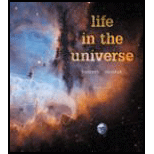
Concept explainers
Is There Life Elsewhere? After considering all the evidence to date about the possibility of extraterrestrial life, do you believe it is likely that we'll find microbial life elsewhere? Do you believe it is likely that we'll find intelligent life elsewhere? Defend your opinions, using arguments based on the full range of scientific issues discussed in this book.
If microbial life is possible elsewhere and chances of intelligent life.
Answer to Problem 1DQ
There is a possibility of existence of microbial life elsewhere due to common elements around universe and also various conditions on earth indicates similar condition in universe making human belief for possibility of microbial life. Intelligent life is also possible in universe.
Explanation of Solution
There is a great possibility of microbial life in universe.
Various evidences for such possibilitiesare as follows:
- The elements that are found on earth are very common in universe and carbon molecules which help in life formation can also be formed easily.
- Life on earth was possible even under harsh conditions which were supposed to be harmful. All these adverse condition made life adaptable to the changes in them with changing condition. These similar conditions are common in all over universe with less variation which makes humans belief that life can exist in universe.
- Earth became habitable after long time of formation of universe. This makes it evitable that there might be other planets too that had life on them.
According to the books it is believed aliens would be much advanced from human civilization. They will be intelligent and more superior. Some books even suggested aliens would come to help and solve problems of human.
Conclusion:
Thus, There is a possibility of existence of microbial life elsewhere due to common elements around universe and also various conditions on earth indicates similar condition in universe making human belief for possibility of microbial life. Intelligent life is also possible in universe.
Want to see more full solutions like this?
Additional Science Textbook Solutions
Biology: Life on Earth (11th Edition)
Chemistry: An Introduction to General, Organic, and Biological Chemistry (13th Edition)
Genetic Analysis: An Integrated Approach (3rd Edition)
Campbell Biology (11th Edition)
Anatomy & Physiology (6th Edition)
Human Biology: Concepts and Current Issues (8th Edition)
- A pendulum bob A (0.5 kg) is given an initialspeed of vA = 4 m/s when the chord ishorizontal. It then hits a stationary block B (1kg) which then slides to a maximum distanced before it stops. Determine the value of d.The coefficient of static friction between theblock and the plane is μk = 0.2. The coefficientof restitution between A and B is e = 0.8.Ans: d=1.0034 marrow_forwardFigure 29-43 Problem 12. ••13 In Fig. 29-44, point P₁ is at distance R = 13.1 cm on the perpendicular bisector of a straight wire of length L = 18.0 cm carrying current i = 58.2 mA. (Note that the wire is not long.) What is the magnitude of the magnetic field at P₁ due to i? P2° R R Larrow_forwardCheckpoint 1 The figure shows the current i in a single-loop circuit with a battery B and a resistance R (and wires of neg- ligible resistance). (a) Should the emf arrow at B be drawn pointing leftward or rightward? At points a, B C R b, and c, rank (b) the magnitude of the current, (c) the electric potential, and (d) the electric potential energy of the charge carriers, greatest first.arrow_forward
- 3. If the force of gravity stopped acting on the planets in our solar system, what would happen? a) They would spiral slowly towards the sun. b) They would continue in straight lines tangent to their orbits. c) They would continue to orbit the sun. d) They would fly straight away from the sun. e) They would spiral slowly away from the sun. 4. 1 The free-body diagram of a wagon being pulled along a horizontal surface is best represented by A F N B C 0 Ꭰ FN E a) A b) B c) C app app The app 10 app d) e) ס ח D E 10 apparrow_forwardPls help ASAParrow_forwardPls help asaparrow_forward
 AstronomyPhysicsISBN:9781938168284Author:Andrew Fraknoi; David Morrison; Sidney C. WolffPublisher:OpenStax
AstronomyPhysicsISBN:9781938168284Author:Andrew Fraknoi; David Morrison; Sidney C. WolffPublisher:OpenStax Foundations of Astronomy (MindTap Course List)PhysicsISBN:9781337399920Author:Michael A. Seeds, Dana BackmanPublisher:Cengage Learning
Foundations of Astronomy (MindTap Course List)PhysicsISBN:9781337399920Author:Michael A. Seeds, Dana BackmanPublisher:Cengage Learning Stars and Galaxies (MindTap Course List)PhysicsISBN:9781337399944Author:Michael A. SeedsPublisher:Cengage Learning
Stars and Galaxies (MindTap Course List)PhysicsISBN:9781337399944Author:Michael A. SeedsPublisher:Cengage Learning

 An Introduction to Physical SciencePhysicsISBN:9781305079137Author:James Shipman, Jerry D. Wilson, Charles A. Higgins, Omar TorresPublisher:Cengage Learning
An Introduction to Physical SciencePhysicsISBN:9781305079137Author:James Shipman, Jerry D. Wilson, Charles A. Higgins, Omar TorresPublisher:Cengage Learning





